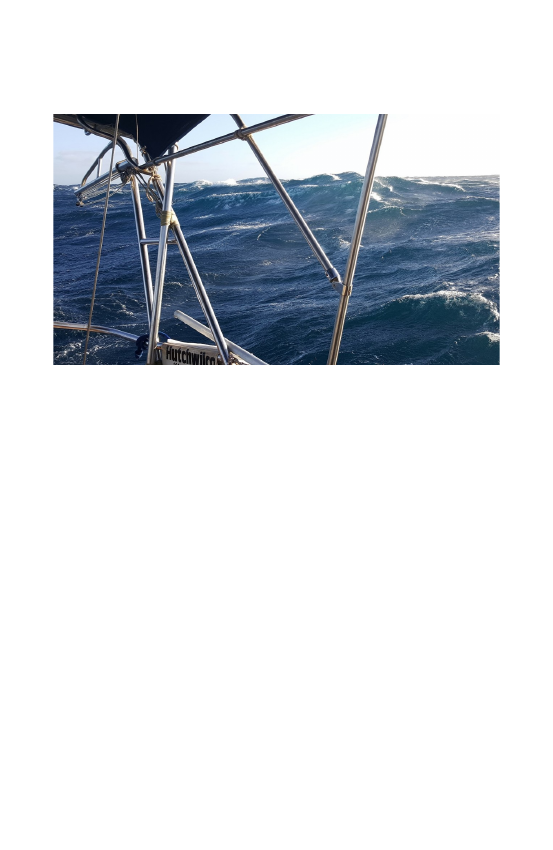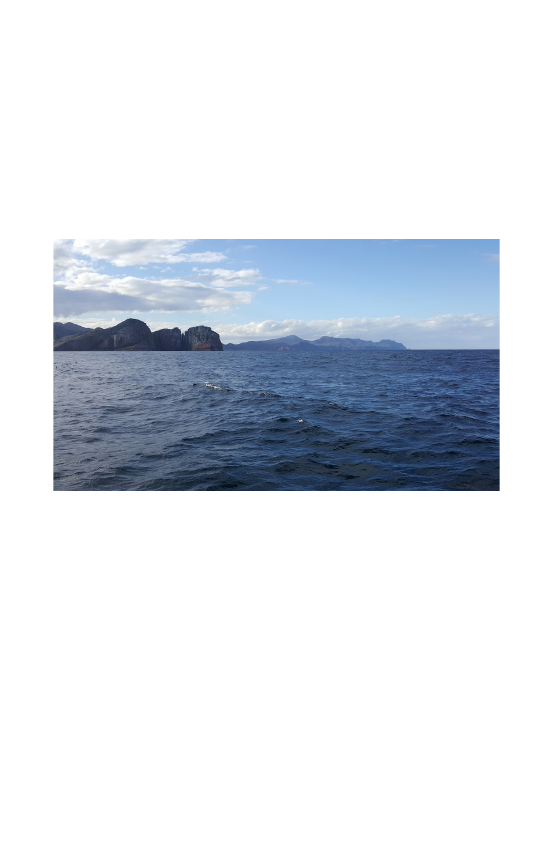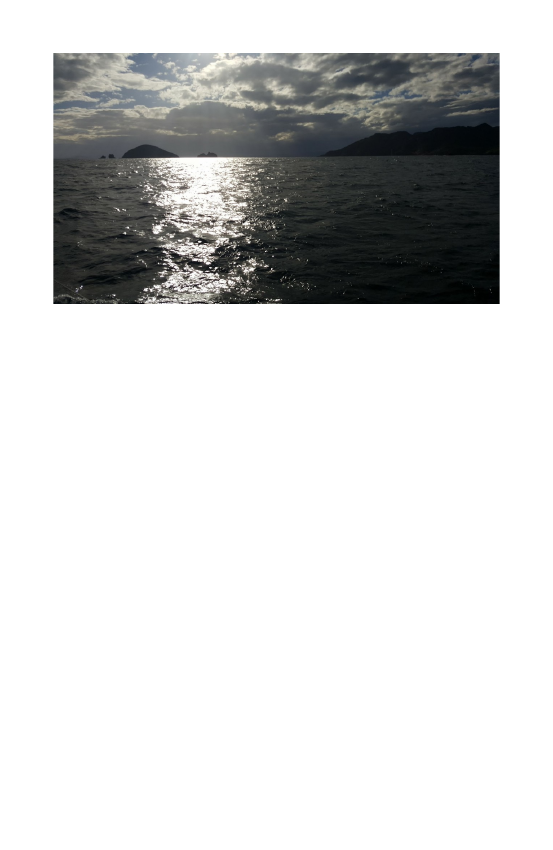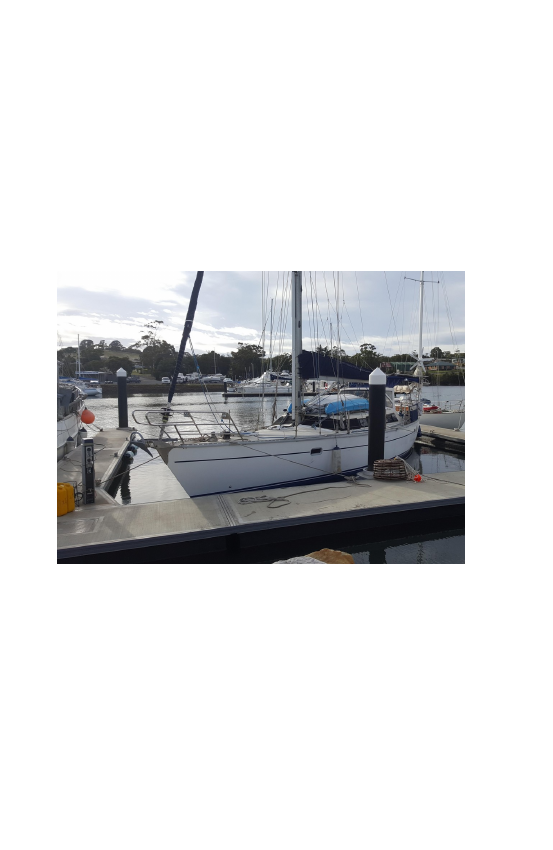
Chapter 4 Bass Strait 2017
Introduction
This event came out of the blue on what should have
been a routine sail south to Tasmania. As many
crews on the annual Sydney to Hobart yacht race
know, crossing Bass Strait is no walk in the park if
the sea turns nasty. I had the Bureau of
Meteorology (BOM) forecast and also took advice
from another prediction system – my mistake.
Here's my story of being hit by an unexpected cold
front coming north from the Southern Ocean and
meeting the easterly flowing waters of Bass Strait.
The Storm
I know not to leave port on a bad forecast, and
being in Bermagui meant I was safe and sound
until the forecast looked good. Now the lesson
to learn is which forecast to rely on. I usually
check two or three. The BOM model and the
USA model are the ones I consult. On this
occasion, I followed the BOM model but relied on
the Predictwind app on my phone. It showed
three days of northerly wind then a swing to the
west. All good. The westerly would come off
1

the land and make the sail down the Tassie coast
nice and flat.
I left Bermagui at noon and set sail for Bass
Strait down the coast southwards. The vessel C-
Star left soon after me. The wind was from
behind and the current was with me, so I made
good time down the coast. I passed Eden late
that afternoon and set off across the strait. I
had my first meal on passage and settled down
for the night, knowing there might be ships. It
was a quiet night with no real traffic. The
following morning, I tried to call C-Star on VHF
as arranged but only got a short, disjointed
message. I heard Painsville calling C-Star on
VHF, so I spoke with them on HF and said they
were behind me and not lost, as a result of
Marine Rescue initiated search. They had not
2

checked in with Lakes Entrance, miles out of
their VHF range.
At that stage, I had done just over 160 nm in 24
hours, a good run. The wind was over 25 knots
and increasing, so I put in the second reef.
Then it hit - a front from the South. Totally
unexpected and with winds more than 40 knots.
I dropped the main and furled the genoa. I
raised the main with the 3rd reef in and started
to beat into the wind as the sun set, but the
wind continued to increase. My log notes
indicated it reached 45 knots at 4:00 am. Not a
great start and so unexpected, but Malua was
going well into a rather calm sea. Then as I
watched, looking forward with my spreader
lights and my forward-facing spotlight
3

illuminating the deck and sea, the wind rose in a
series of gusts well over 45 knots.
The waves were now building and Malua was
moving forward nicely. Malua started to rise
over a wave and then it hit. A big one over the
starboard bow. White water filled the staysail
and bang - the stay parted at the head, and I
watched, as they say, in slow motion, as the sail
and furler went over the port side into the water.
Spring into action. Let go the main halyard and
drop the sail, but it jammed before totally
furling. It stuck flapping in the now 45-knot
wind. I finally pulled it down and moved forward
to try and get the staysail on board. It was at
this time attached at its head to the halyard up
the mast and the base was
secure. The sheet was
holding it onboard, but a lot of
the sail and rigging was in the
water. Then the base with the
furler drum came loose and
went over the side.
I was able to secure a line to
it and, via a block and the
winch, pull it over the lifelines
and up to the bow anchor
4

area. It was secured, but the head was over the
port side supported by the halyard. If I let that
go, it was dangerous, so I passed a line around
the sail and pulled it alongside the boat but up in
the air just above the furiously spinning wind
generator. Stop, think. OK, stop the wind
generator by using the electric brake and tie off
the blades. I completed that in a few precarious
minutes and set about recovering the head of
the foresail. I slowly loosened the halyard and
lowered the bent and twisted Profurl furler
alongside the boat. All this time I was wallowing
in the ever-increasing waves and wind. Finally,
the sail and furler were secure along the port
side of Malua, and I could now focus on sailing
the boat with the sails I had left.
I looked at the wind gauge and found the wind
was still in the 45 or more range. I was not
going anywhere this evening. I unfurled a bit of
the genoa, pulled hard on the sheets, and
turned the wheel into the wind and tied it off.
Malua was now heaved to or lying a-hull. It
doesn't matter what you call it, but Malua was
sitting nicely in the water. There were very few
large waves and none like the Tonga storm from
the Southern Ocean. I took a shower, changed
5

into some dry clothes, and settled down to wait
for dawn.
I was 50 nm from Flinders Island and moving in
a south-eastern direction at about 2 knots with
very few waves disturbing me. I climbed into
bed and set the alarm for 27 minutes and slept.
When I woke, I looked out the portlight adjacent
to my bunk to check the waves, wind, and
weather – nothing had changed. The wind was
still at 35 knots or more. Back to sleep. So it
went until the sun rose. Wind still at more than
35 knots, but the warmth of the sun was a good
sign. At about noon, almost 18 hours after the
staysail came down, I started the engine and
turned south for Hobart. The sea had become
more confused, and we made only slow
progress.
Then the radio went off: "All ships, all ships, etc.
Has anyone seen C-Star?" I again
communicated with Painsville, this time on HF,
and told them about the storm last night and
that I was OK heading to Triabunna and would
try calling C-Star on VHF. No luck.
I subsequently heard they had telephoned
Marine Rescue with their sat phone to say they
were returning to Eden. This message had not
6

been passed to Canberra. I never check into
Marine Rescue for this reason. They will start a
search just because someone travelling along
the coast has not been able to update their
plans. Thankfully, Canberra knows better and
uses all available resources to contact vessels in
the area to assist.
The wind dropped as suddenly as it rose, and I
continued to motor down the coast for the rest
of that day and through the night. At 5:00 am
the following morning, I switched from the
forward diesel fuel tank to the aft tank. As I
switched, I watched the vacuum gauge go from
yellow (good) to red, and the engine started to
splutter as it could not getting any fuel through
the line. I could see a dirty black mass in the
fuel filter. A quick switch of filters to the
7

alternate and a switch of tanks back to the
forward tank, and I was off again.
Now I had a problem. No wind and little fuel in
the forward tank, and about 80 nm to any
destination. I always keep 40 litres in two
containers in the aft cockpit locker. I lifted the
first, full, so it went into the forward tank. I
located the second, but it was empty. What had
gone wrong?
The only feasible solution was to get fuel from
the aft tank, but it would not come through the
block lines. So I used the outlet at the base of
the tank to draw off fuel. I drained some fuel
into a container, but it was full of black fungus
from the diesel algae. Black sludge like jelly. I
tried again and again till finally, it started to run
reasonably clear. OK, I had clean fuel in a small
container but blocked lines. What to do next?
How could I filter it? The only thing I could think
of was through a small funnel with a coffee filter
placed in it. It was a slow process, drop by
drop. It required many refills to get the clean
fuel in the lower container. Finally, I had enough
extra fuel – about 5 litres to make it to
Triabunna if the wind did not come up.
8

Still no wind as I rounded the southern arm of
the Freycinet Park. The sun was starting to set,
and I had not reached Prosser Bay near Orford.
But no worries, there is a full moon tonight, and
I will be able to see the land which I know from
previous cruises. I motored at the optimum
speed to save fuel as it got dark. The moon was
in the east just above the mountains as I passed
northeast of Maria Island and toward the bay.
Then the moon disappeared behind the
mountains, and I was left in total darkness.
The light of Orford was my only guide along with
the chartplotter and radar. I eased into the bay
and dropped the anchor. I pulled back to see
that it was set well and turned off the engine.
Silence. Food, shower and sleep.
9

I woke after a great night's sleep to find I was
right in the middle of the bay, a long way from
the shore.
I cleaned up the mess down below and followed
another yacht up the channel of Spring Bay and
into Triabunna. I was right out of fuel as I tied
up alongside and tried to arrange a tanker to fill
Malua's tanks.
No magic moment on Malua
The next Chapter just highlights the importance
of a weather forecast.
10









